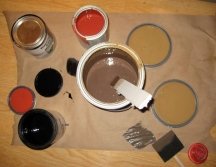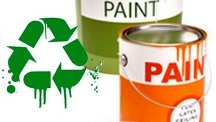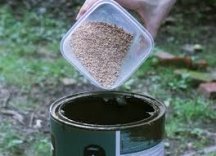Paint Disposal:
How to Get Rid of Old Paints
Proper paint disposal practices are not just about complying with some local red tape regulations.
The way we individually get rid of our household paint leftovers makes a huge difference in how much of an impact we collectively leave on our planet.
All house painting projects result in excess - unused extra cans that can't be returned, sample jars, paints saved for touch ups that you don't need anymore, and even full cans of wrong color paints.
That stash can accumulate and grow over the years to the point where you finally have to do something about it, but paint disposal (even if done properly) is not the best or only way to deal with unwanted paints in your garage.
So before just throwing it all away, see if you can find some other use for your old paints first - you will help the planet, may help another, or even help yourself.
Paint Disposal Instructions
and Alternative Solutions
Use it up
The best way to handle the extra paint issue is to actually use up the excess (if you store the paint properly, it will remain fresh for many years so you can use it again some day).
In addition to keeping the paint out of our landfills, using up your stash will also save you money and even give you an opportunity to have a good, quality time with your family doing a fun, creative project together.
For example, you can:

- Combine paint leftovers in similar colors and mix them all in one
container, or even mix different colors together (if you are the adventurous kind) - oftentimes you will get a nice shade and enough paint for another
project in your home.
NOTE: you can only blend the same types of paint successfully, so read the labels to know what you are dealing with - interior or exterior paint, water-based/latex/acrylic or solvent/oil-based/alkyd formula. - Apply 1 coat of flat
paint to unfinished wood and drywall instead of a primer - it will
protect the bare surfaces (even if you decide not to topcoat them) and
allow the finish coat to bind properly.
NOTE: light-colored "primers" work best under light to medium finish coat colors; medium to deep toned "primers" are better used under dark topcoats (to avoid bleeding through).

- Use your leftover
paints in areas where the finish color is not critical or to funk up a
boring space - utility closets, inside the shed or cabinets/drawers,
etc.
- Put on your creative hat and have fun with the leftover colors - you can paint furniture, accent walls, multi-colored stripes, blocks, primitive murals or even wild abstracts on the walls in your garage, basement, hobby room or your kids' room!
Pass it on
Since one man's trash is another man's treasure, you can give your unwanted paints a new life and create a win/win solution.
Get rid of your stash by offering it to someone else who may need it and can put it to good use.

- Ask your friends,
neighbors or family members if they want the paint colors you have. You never know - it might come in handy for
their own small house painting projects.
- Donate your paint
to a local charity, high school drama department, church or Habitat for
Humanity chapter where they can always find a use for it.
- Make a few bucks by selling your old paints at a garage or yard sale (they will go much faster than that pasta-making machine).
- Post an ad on Craigslist or FreeCycle Network bulletin board and someone may offer to take the paint off your hands within minutes!
Recycle it
Another great alternative to paint disposal is recycling.
Here's what usually happens to the paints you recycle (depending on the program):

- About 2% of the salvaged paints is re-distributed or re-sold by household hazardous waste centers and retailers such as
Habitat for Humanity ReStores.
- Water-based paints (latex, acrylic) that can't be re-distributed or re-sold are sorted by color, filtered
and then blended together (sometimes with the addition of other virgin ingredients),
to make recycled-content paint.
- Water-based paints
unsuitable for
re-blending are often used for other purposes - for example, as an
additive in other products, concrete, cement and landscaping materials
(water based paints are sent to landfills only when no other practical
options are available).
- Oil-based paints that can't
be re-distributed are usually re-used at cement manufacturing plants as
fuel to help operate the kilns and save virgin fuel (right now it's the
most common and environmentally responsible use of unwanted oil-base
paints).

So how do you recycle your old paint?
Here are your best options:
- Ask
your local paint store if they accept leftover paints for re-blending -
chances are you will get a "yes" (or a referral) because some major
paint manufacturers have started making and selling recycled-content paints.
NOTE: don't be surprised if they only accept the products they sell or brands they are affiliated with.
- Search
the Internet for "paint recycling drop-off" sites in your area, then
put your paint cans in a sturdy cardboard box (so that they do not tip
over and create a mess in your trunk) and take
them to your local recycling point.
Interior and exterior paints and primers, wood stains and clear coatings, concrete and masonry sealers, as well as rust preventatives and lawn paints are usually all accepted (both water and oil based formulations), but solvents, aerosols and products intended for industrial use will be rejected.
NOTE: most centers do not accept open or leaking cans. Also, the paint must be in its original container with the original manufacturer’s printed label still on.
- Try to recycle empty paint cans because many centers accept them - all you need to do is ask.
Also, some trash removal companies allow empty, dry paint cans to be put in recycling bins for pick up - so find out if yours does before just tossing them in your regular trash.
Dispose of it
Even though not all paints are considered hazardous waste, they can all contaminate the environment, so proper paint disposal practices are very important.

- Water-Based Paint Disposal:
To dispose of latex or acrylic paint, it must be solidified first.
Mix the paint with mulch, cat litter, shredded paper or sand and let it dry up with a lid open in a well ventilated area, away from children, pets and direct heat. Once it's hardened, you can put it in your regular household trash. - Oil-based Paint Disposal:
Oil-based paint must never be put in your regular trash. Instead, it should be taken to your local hazardous waste collection site (click here to find a waste disposal facility in your area that accepts oil-based paints).
These last 2 paint disposal methods do help minimize the pollution, but hopefully you will use them only as a last resort, after trying the other more environmentally friendly solutions first (described earlier on this page).
See Also:
How to Touch Up Paint in Your Home
Removing Mold and Mildew Stains from Paint
Caulking and Painting: 4 Little-Known Benefits









Leave a Comment: